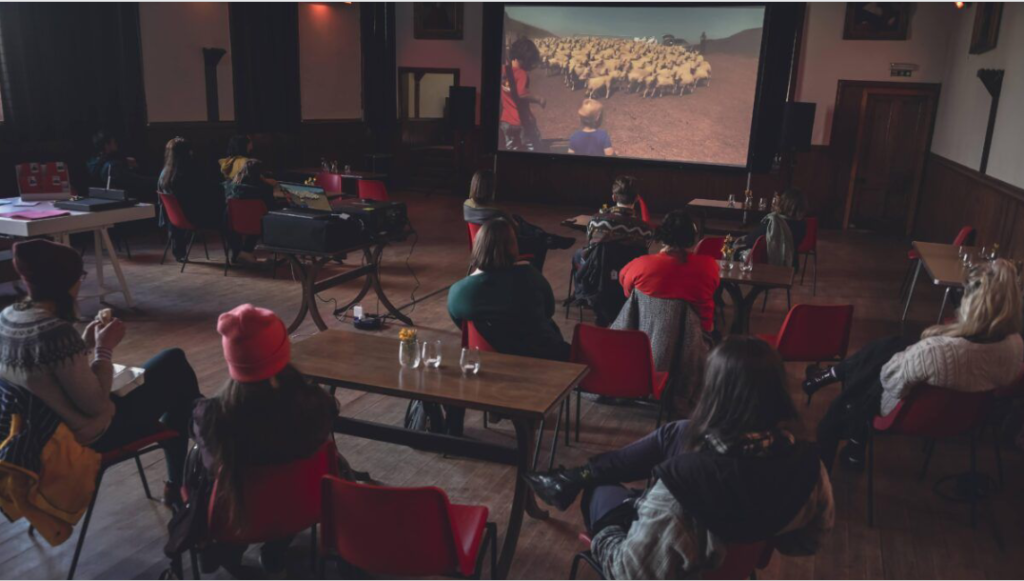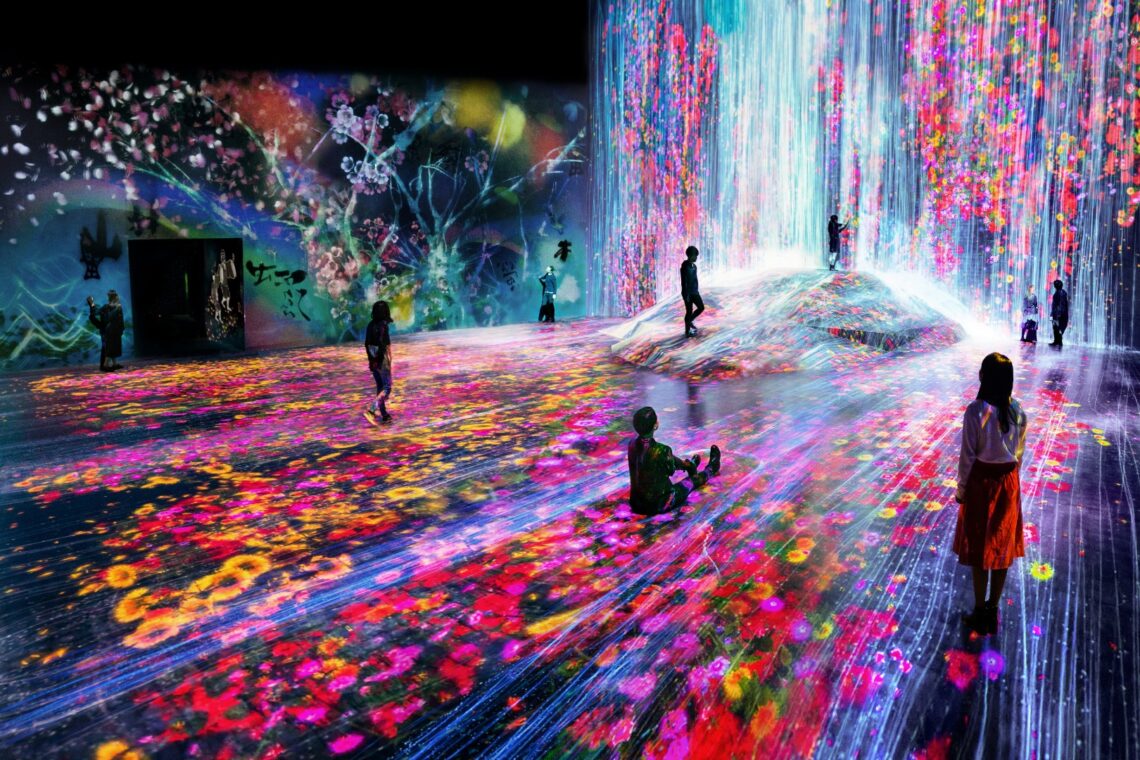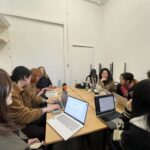1️⃣ Introduction: Defining the Direction Through Feedback
Over the past few weeks, I have refined my curatorial project based on readings, lectures, peer reviews, and tutorial discussions. My exhibition explores the concept of Expanded Cinema, moving beyond traditional film screenings into interactive, spatial, and installation-based experiences.
Through peer discussions and tutorial feedback, several key issues emerged that require further refinement:
1️⃣ Structural Clarity: Should my project focus on three distinct exhibition models (Interactive Film Curation, Community Screenings, and Unfinished Film Curation) or streamline it to emphasize just two?
2️⃣ Audience Interaction: How much agency should audiences have in shaping the cinematic experience? Should participation be passive (e.g., pre-recorded interactive sequences) or active (e.g., real-time live performance integration)?
3️⃣ Technical Feasibility: How can I practically implement interactive narratives in a physical exhibition space rather than just on a screen?
After receiving feedback, I have begun restructuring my exhibition model, integrating new theoretical perspectives and case studies to enhance the project’s feasibility and impact.
This week’s lecture on place-responsive curatorial programming provided valuable insights, especially regarding how different sites and technologies shape curatorial decisions. These reflections push me to refine my exhibition model and reconsider how audience interaction can be integrated without compromising curatorial intent.

2️⃣ Critical Reflections on Lecture: Place-Responsive Curating
This week’s lecture by Frances Davis explored place-responsive curatorial programming, offering useful considerations for curatorial approaches. ATLAS Arts operates in non-traditional, site-specific contexts, organizing exhibitions across rural, island, and coastal landscapes rather than conventional gallery spaces.
Key Insights for My Project:
✅ Multi-Sited Storytelling: Samhla (2024) was displayed across five locations in North Skye, altering audience perception depending on the site. Similarly, my project can explore site-responsive Expanded Cinema, where films are exhibited in different environments to shape unique audience experiences.
✅ Community Engagement: ATLAS Arts’ School of Plural Futures fosters participatory discussion about the social and political realities of place. My project can integrate community involvement by inviting audiences to shape the film narrative through live interactions.
Applying to My Exhibition:
📌 Consider alternative screening locations—e.g., abandoned buildings, parks, or urban spaces—to create immersive site-specific film experiences.
📌 Use oral history elements, inspired by Tobar an Dualchais, allowing audiences to contribute their own narratives to the exhibition.

3️⃣ Peer & Tutor Feedback: Refining the Curatorial Strategy
🔹 Key Feedback from Peer Review & Tutorial
1️⃣ Too Many Exhibition Models? Some peers suggested that my three-part structure (Interactive Film Curation, Community Screenings, Unfinished Film Curation) might be too fragmented. Would it be more effective to focus on just two core models?
Adjustment:
✅ Instead of three separate sections, I am considering merging interactive film curation with unfinished film curation to create a hybrid format where audiences engage with incomplete narratives and shape their development.
2️⃣ Audience Interaction: The level of interactivity remains unclear—should the audience have pre-recorded choices (like Bandersnatch) or live role-playing experiences (like Punchdrunk)?
Adjustment:
✅The best approach is to allow audience choices to shape the story in real-time while maintaining a structured narrative. Using motion sensors and projections, their movements and interactions can influence the visuals, creating an engaging and immersive experience without losing curatorial direction.
3️⃣ Technical & Spatial Feasibility: How will the physical movement of audiences be managed? Should there be a structured pathway or an open, nonlinear experience?
Adjustment:
✅A semi-structured approach works best—key scenes guide the audience, but they can explore freely. Subtle lighting or motion sensors naturally direct movement without restricting choices.
4️⃣Identifying Issues: Why Do These Challenges Exist?
🔹 Structural Fragmentation – Should the Project Be Streamlined?
One critique from the peer review was that the three exhibition models (Interactive Film Curation, Community Screenings, Unfinished Film Curation) might be too disjointed. This issue arises because each model has a distinct conceptual basis.
📖 Bishop (2012) critiques participatory art as “sometimes being a curatorial illusion of inclusivity, where audience agency appears expanded but remains curatorially controlled” (Bishop, 2012). This tension is evident in my structure—if audiences engage in interactive film choices, can the same curatorial logic apply to unfinished films?
📌 Case Study: Punchdrunk’s Immersive Theatre
Punchdrunk’s Sleep No More (2011–present) presents a non-linear narrative, where audiences are free to roam the space and construct their own experiences. However, the overall structure is still carefully designed to maintain coherence. My project can draw from this model by allowing audience freedom within structured parameters rather than completely open-ended interaction.
🔹 Audience Engagement – How Much Freedom Should They Have?
Some peers questioned whether the interactive component should allow open-ended audience control or structured engagement.
📖 Bandersnatch (Black Mirror, 2018) demonstrates pre-scripted audience interaction, while immersive theatre like Punchdrunk’s Sleep No More allows free movement and role-playing. Which model aligns best with my project?

📌 Case Study: teamLab’s Digital Exhibitions
teamLab’s installations invite audience participation without breaking curatorial intent. Their work Borderless (2018) in Tokyo allows visitors to alter digital projections, yet the overall exhibition remains a cohesive experience. This suggests a possible model: interactive Expanded Cinema with controlled variability, where audiences can influence aspects of the film but within a structured framework.
5️⃣ Optimizing the Curatorial Model: Proposed Revisions
Merging Models for Cohesion
🔹 Interactive & Unfinished Film Hybrid – Creating a single fluid exhibition where audiences contribute to, alter, and experience unfinished films in real-time.
📌 Technical Feasibility: Using motion tracking (teamLab) or gesture-based interactions (Frameless London) to allow participation without disrupting the film’s artistic intent.
conclusion:
Refining my Expanded Cinema exhibition, I merged Interactive Film Curation and Unfinished Film Curation for a more cohesive experience. Drawing from Punchdrunk’s immersive storytelling and teamLab’s digital interactivity, audience choices will shape the narrative within structured parameters, similar to Bandersnatch (2018). Motion tracking and projection mapping, inspired by teamLab Borderless and Frameless London, will guide engagement while preserving curatorial intent. Moving forward, I will refine technical logistics to balance interactivity and artistic control, ensuring Expanded Cinema remains both immersive and thoughtfully curated.







